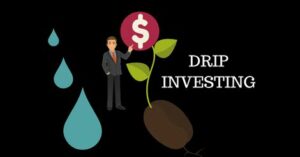If you are looking for ways to invest in the stock market and are interested in generating a steady and passive income, dividend investing might be the right path for you. Among several strategies of dividend investing, one that stands out is DRIP or Dividend Reinvestment Plan. It is a powerful investment approach that enables investors to buy stock fractions with dividend payments. In simple terms, a DRIP is a type of investment that automatically reinvests dividends paid by companies back into more shares of stock. In this blog, we will explore the DRIP method of dividend investing, how it works, its benefits, drawbacks, and how to start DRIP investing. We will also delve into how to select best DRIP stocks, and important dividend investing calculations that you should know to master the art of DRIP investing.
right path for you. Among several strategies of dividend investing, one that stands out is DRIP or Dividend Reinvestment Plan. It is a powerful investment approach that enables investors to buy stock fractions with dividend payments. In simple terms, a DRIP is a type of investment that automatically reinvests dividends paid by companies back into more shares of stock. In this blog, we will explore the DRIP method of dividend investing, how it works, its benefits, drawbacks, and how to start DRIP investing. We will also delve into how to select best DRIP stocks, and important dividend investing calculations that you should know to master the art of DRIP investing.
What Is a Dividend Reinvestment Plan (DRIP)?
A dividend reinvestment plan, or DRIP, is a program that allows the investors to use their dividends to buy more shares in a company without requiring initiation of a transaction. It’s a straightforward approach towards compounding your returns through a regular piece of income. DRIPs are an excellent way to reinvest your income in stocks that pay you to own them. They’re commission-free, offer a discount to the current share price, and are offered by almost 650 companies and 500 closed-end funds. Using a DRIP to reinvest dividends can help save money and maximize investment returns in the long run. DRIP is an excellent and safe option for investors who want to build their wealth through compound returns.
How DRIPs Work
DRIP stands for “Dividend Reinvestment Plan,” which is a method of investing that allows investors to reinvest the dividends they earn, so they can accumulate more shares of the stock. It’s a direct purchase of common stock from a company’s share reserve. By choosing a DRIP, one can accumulate capital over the long term at a steady pace. The plan is usually administered by the company or a third party transfer agent. Companies like Coca Cola, Kellogg, Colgate-Palmolive, Microsoft, and Johnson & Johnson participate in DRIPs, making it an excellent method of dividend investing. The choice of DRIP varies according to personal goals and the specific stock in which an investor is interested. Automatic reinvestment of shareholder dividends is an attractive feature of DRIP, making it easier for investors to grow their portfolios over the long term.
How to Start DRIP Investing
DRIP (Dividend Reinvestment Plan) investing is an excellent way to invest in a company’s shares and optimize your dividend strategy. Companies offer direct stock purchases and DRIPs through transfer agents. DRIP can allow investors to buy fractional shares with their cash dividends on the dividend payment date, turned into additional shares of stock. Before starting a DRIP, make sure you evaluate your personal goals and the specific stock. Over 650 companies and 500 closed-end funds offer formal DRIP programs to their existing shareholders, so finding a company that fits your needs shouldn’t be difficult. With DRIP, you can maximize the value of your investment, and it’s an excellent strategy for those looking for a long-term investment opportunity.
Benefits of DRIP Investing
DRIP, or dividend reinvestment plan, is a popular investment strategy that aims to maximize value and returns through dividend payments. One of the most significant benefits of DRIP investing is the elimination of transaction fees used to purchase additional shares. Moreover, many companies offer a share purchase discount, which can help increase your position in their stock at a reduced price. DRIPs offer a form of passive investing where dividends are automatically reinvested back into the stock, increasing wealth through compound returns. DRIPs make it simpler to build your wealth without requiring in-depth knowledge or active management, making them an essential tool for any investor looking for a low-cost long-term investment strategy.
Dividend Reinvestment Plan Disadvantages
Dividend Reinvestment Plans, or DRIPs, have some distinctive advantages, such as compound interest and no fees. They are also a convenient option for investors who want to steadily grow their investment portfolios. However, there are several disadvantages, like a lack of control over investments and possible tax implications. A DRIP investment can be either full reinvestment, partial reinvestment, or optional cash payment. It is crucial to evaluate individual investor circumstances and goals before deciding on a DRIP. Overall, dividend reinvestment plans can provide an accessible and effective way to achieve a long-term investment objective, but it’s important to weigh the potential disadvantages against the benefits.
Dividend Reinvestment Plan Tax Treatment
The Dividend Reinvestment Plan (DRIP) is a popular method of investing in the stock market. The taxation of DRIPs and their dividends can be a bit tricky. Dividend income from DRIPs is taxable, much like cash dividends. However, qualified dividends receive favorable tax treatment similar to long-term capital gains taxes.
The taxation of DRIPs depends on various factors such as the holding period, type of investment, and the investor’s overall taxable income. Qualified dividends are taxed at a lower rate than ordinary dividends. Ordinary dividends are taxed as ordinary income, whereas qualified dividends are taxed at either 0%, 15%, or 20%.
When investing in DRIPs, it’s important to receive a Form 1099-DIV from the brokerage or direct stock purchase provider. Also, keep in mind that some investments, such as REITs, employee stock options, or MLPs, are not considered qualified dividends. Understanding the tax treatment of DRIPs is necessary for investors to plan their investment strategies effectively.
Should I DRIP?
Whether or not to DRIP (Dividend Reinvestment Plan) depends on your financial goals and the specific stock you’re invested in. DRIP allows investors to reinvest dividends into additional shares/fractional shares, which ultimately simplifies building wealth through compound returns. When investors keep reinvesting, their wealth can snowball over time without having to buy additional shares of stock each time. Companies allow DRIPs through direct stock purchase or transfer agents. DRIPs may be offered by publicly traded corporations that pay out regular dividends. If you’re considering DRIP, it’s important to research and understand the tax implications and potential fees associated with the plan.
How to Select the Best DRIP Stocks?
When selecting DRIP stocks, it’s essential to consider fees, dividend growth history, and dollar cost averaging. Start by looking for DRIP stocks that don’t charge any fees. This approach will help you avoid paying fees while you use dividends to build larger positions.
Another way to select DRIP stocks is to consider companies that offer their dividend reinvestment plans, allowing investors to build up a holding of more shares directly. Dividend aristocrats listed in the S&P 500, with 25 years of increasing dividend payments, are a reliable option for using dividends to buy more shares.
Using DRIPs, you can purchase shares at a fixed date and time each month at the prevailing market price, using dollar cost averaging as an effective wealth accumulation method. This approach helps stabilize a company’s share price and keep capital inside the company through reinvesting dividends in additional share purchases. Happy investing!
Pros and cons of DRIPs
The DRIP method of dividend investing has both pros and cons. The immediate reinvestment of dividends and lower commissions are among the advantages of DRIPs. However, DRIPs may throw off the balance of your portfolio and lack diversification. The effectiveness of DRIP investing depends on your personal investment goals and the specific stock you’re investing in.
One of the potential benefits of DRIPs is that they can provide a steady stream of income. On the flip side, they may have drawbacks, such as the lack of control over the timing and price of reinvested dividends. As with any investment strategy, it’s essential to weigh the possible benefits and drawbacks of DRIPs carefully before investing.
Important Dividend Investing Calculations
The Dividend Reinvestment Plan, also known as DRIP, is a popular way of dividend investing. It has both pros and cons, similar to regular investing. DRIP investing provides the convenience to grow your portfolio. Dividend yield is a widely used ratio to track income stocks and understand the potential benefits of reinvesting in them. However, it’s important to consider any potential drawbacks of DRIP plans. While they can increase your position with no fees and automatically reinvest dividends, they may not be worth it if you need the income or want to reallocate positions.
If you are an income investor looking to maximize your investment returns, DRIP may be an excellent strategy for you. It can help you increase your investment returns and achieve your financial goals. Understanding the calculations of dividend investing can be extremely useful while planning your investments. By leveraging DRIP correctly, dividend investors may be able to achieve financial success while reducing risk.
Dividend Yield, or Current Yield
One of the most important calculations in dividend investing is the dividend yield, also known as the current yield. The dividend yield is the ratio of yearly dividends paid to the current share price and can fluctuate with changes in stock prices and dividend payouts. For income investors, dividend yield is an important factor to consider as it represents the return on investment if the company continues to pay out the same dividend.
It’s important to understand how dividend yield is calculated in order to make informed investment decisions, but it’s not the only factor to consider. Additionally, calculating yield on cost is necessary to determine the true return on investment for stocks that pay dividends. By keeping track of dividend yield and yield on cost, investors can ensure that they are making the most of their investments in dividend-paying stocks.
Yield on Cost
When it comes to dividend investing, understanding the calculations behind your investments is crucial to making informed decisions. One important calculation is yield on cost, which helps determine the true return on investment of a dividend stock by using the average share price paid instead of the current share price.
To calculate yield on cost, you need to first understand dividend yield, which represents the ratio of dividends paid out per year compared to the current share price. Yield on cost then takes into account the fact that you may have purchased the stock at a higher (or lower) price than its current value, giving a more accurate picture of your return.
Knowing how to calculate stock dividend yield and yield on cost can help investors decide on the best investment route for their money. Yield on cost can be especially beneficial for investments you already own, as it gives a clearer understanding of the long-term return on your investment. By utilizing these calculations, dividend investors can make informed decisions and maximize their potential returns.
Dividend Payout Ratio
When it comes to dividend investing, understanding important financial calculations such as the dividend payout ratio and dividend yield are key. A good dividend payout ratio is important in dividend investing, and most successful dividend investors avoid companies with a payout ratio above 50% or 60%.
Dividend yield is another widely used financial ratio that can be used to track income stocks. It can be used to calculate both trailing and forward yields for preferred and common stocks. However, it’s important to note that consistently high dividend yields may not be sustainable over the long-term.
Reinvesting earnings back into the organization is critical for company growth, and the DRIP (Dividend Reinvestment Plan) method can be a powerful tool for investors who are looking to maximize their returns. By reinvesting dividends back into the company, investors can take advantage of compounding interest and potentially earn even greater returns in the future.
Conclusion
Dividend reinvestment plans can be a smart way to invest and grow your wealth for the long term. DRIPs can help you compound your returns and reach your financial goals faster. Moreover, DRIPs allow investors to own fractional shares of stocks, providing a practical and affordable way to invest in high-priced stocks. However, as with any investment, DRIPs also have their disadvantages and risks. To learn more about the DRIP method of dividend investing and how it can benefit you, check out our comprehensive guide to DRIP investing.


